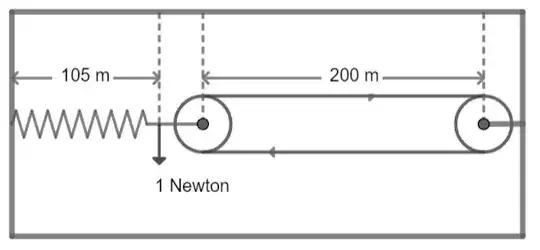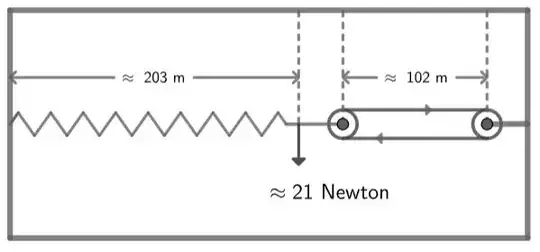EDIT: It appears there is a position taken by some, that there is no force measured and the chain drive does not shorten at all, however fast the chain is moving in the lab. I would genuinely appreciate thoughts, opinions and feedback on this alternative position.
While putting together an answer for this question "Relativistic Chain Drive Paradox" it occurred to me that the set up provides a really good demonstration of the physicality of length contraction and can also demonstrate that it is associated with a real force. The Bell Rocket ships paradox does the same, but this mechanism could in principle be set up in an Earth lab and demonstrate length contraction that can be measured by a static ruler in our own reference frame and observed to occur right before our very eyes.
The slightly modified set up (Illustrated above) requires a driven gear with a fixed axle and an idler gear that that keeps the chain drive under a small tension due to being attached to a spring balance which is attached to something solid like a wall. We now turn on the gear drive and observe the chain contract to say half its stationary length. The tensioning spring balance was initially reading say 1 newton, but at full speed the balance is reading a greater force.
Edit: I moved my self answer to here to show my attempt at an answer. The calculations are now less relevant as the question has become is there any force of contraction observed at all?
Assume the spring constant of the spring is $0.2 N m^{-1}$. It is initially set up with a tension of 1 newton so it has a length of 105m when set up. Assume the chain links have a spring constant or stiffness of $10 Nm^{-1}$ and the distance between axle centres of the pre-tensioned chain drive is 200m. This means the un-tensioned length of the chain drive is 199.9m. Now we start the drive gear and accelerate the chain up to a constant speed of $v = \sqrt{3/4}$ as measured in the lab, such that the gamma factor $g = 1/\sqrt{1-3/4} = 2$ using units such that c = 1. The chain drive now looks like this:
Notice that gear wheels themselves have been allowed to shrink by a factor of approximately 2 along with the chain itself. The force on the spring balance is $F_s = k_s d_s$ where $k_s$ is the stiffness of the spring and $d_s $ is the displacement of the spring. $d_s$ in turn is defined as $(L_s -$ un-tensioned length of the spring), where $L_s$ is the current tensioned length of the spring. $F_s = k_s d_s = 0.2 (L_s - 100)$ The balancing force on the chain drive is correspondingly $F_c = k_s d_s$. We have to remember to divide the relaxed length of the chain drive by 2 due to the length contraction factor so $F_c = k_c d_c = 10 (L_c - 199.9/2)$ Since the system is in equilibrium $F_s = F_c$ and $0.2 (L_s - 100) = 10 (L_c - 199.9/2)$ The total length of the chain drive and the spring scale was initially 105 + 200 = 305 and the total remains the same after the chain drive starts operating so we can say $L_s + L_c = 305$. We now have 2 unknowns and 2 equations so it is a simple simultaneous equation, and the solutions for the lengths of the spring and the chain drive are $L_s \approx 202.99m$ and $L_c \approx 102.01$ as in the diagram. The force indicated on the spring balance, while the drive is operating is $F_s = k_s d_s = 0.2 (202.99 - 100) \approx 20.598 N$. Note that while the gamma factor is 2 the chain did not quite contract by a factor of 2, due to the tension on the chain.
P.S. Ignore contraction of the gears themselves. Assume they have been engineered to reduce their diameter as required while not affecting the length of the chain.

